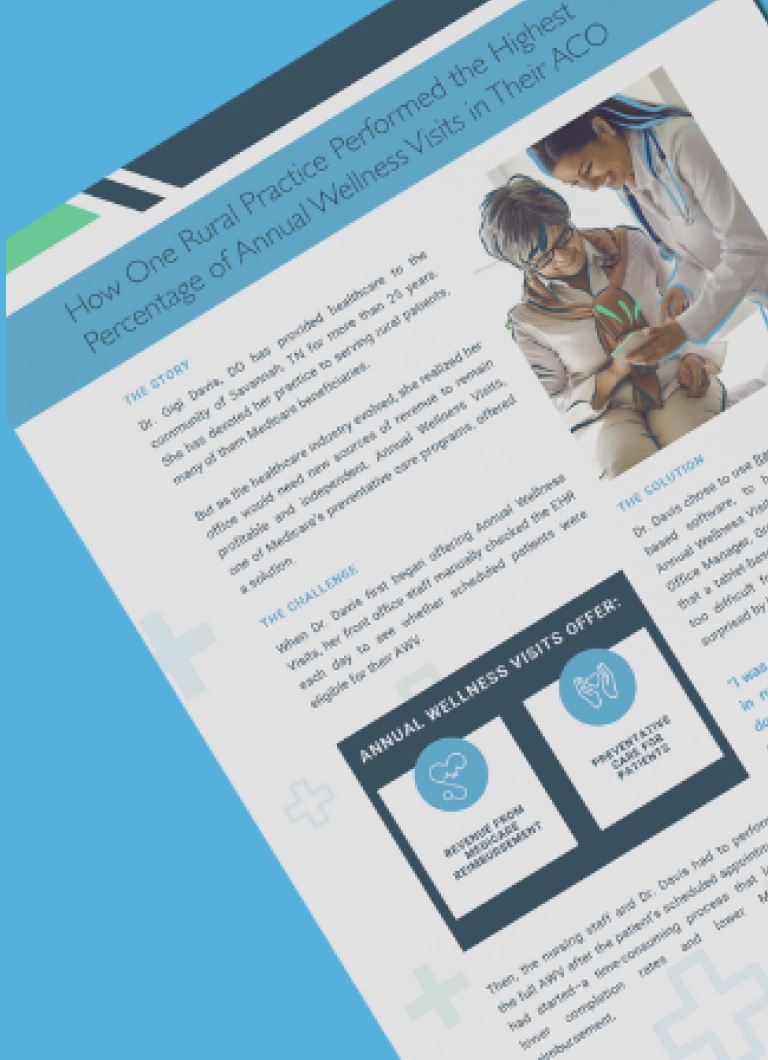
Talk with a ChartSpan Representative Today!
Our team is ready to help you improve patient care and outcomes.
Blog
What Are Gaps in Care and How to Close Them
Gaps in care gaps arise when patients don't receive recommended care, like regular screenings or necessary treatments. These gaps cost the U.S. healthcare system time and money and lead to worsening chronic conditions, preventable diseases, and increased strain on healthcare resources.
Unmanaged care can result in delayed diagnoses, higher treatment costs, and lower quality of life. This can lead to escalating treatment costs, more invasive surgeries, and deteriorating quality of life. Medication non-adherence alone contributes to 125,000 deaths annually.
Eliminating care gaps improves quality scores and increases reimbursements for value-based care and quality improvement programs, but it requires intensive effort and resources. In this article, we’ll explore strategies to close care gaps and highlight how Annual Wellness Visit software and Chronic Care Management programs can support these efforts.
What is a gap in care?
A gap in care occurs when a patient doesn’t receive the care recommended based on best healthcare practices. For example, a high-risk patient missing an annual mammogram creates a gap in care, leaving the provider without crucial information to effectively manage their health.
Examples of gaps in care
Gaps in care can occur when a patient:
- Does not take medications as prescribed.
- Misses important screenings like mammograms, colonoscopies, or cardiovascular tests.
- Lacks necessary testing for chronic illness management.
- Fails to schedule critical appointments such as wellness visits or behavioral health checkups.
- Misses vaccines or boosters.
- Cannot arrange transportation to medical appointments.
- Experiences poor communication between primary care doctors and specialists about diagnoses or treatments.
- Struggles to find in-network or local care.
Unresolved gaps increase the risk of serious, undetected health issues.
What causes gaps in care?
Gaps in care are created when patients don’t follow through on recommended treatments, leading to missed diagnoses, delayed care, and worsening health outcomes. Several factors contribute to these gaps.
Medication non-adherence
Medication non-adherence is one of the most significant contributors, with about 50% of chronic disease patients discontinuing refills after the first year of diagnosis. Approximately half of patients with chronic diseases do not take their medication in accordance with their prescriptions.
Social Determinants of Health
Factors like the inability to afford medications, lack of transportation, and other SDOH issues prevent patients from accessing necessary care. These barriers are especially prevalent among underserved populations.
Lack of support
Patients may feel overwhelmed by their health conditions or unsupported by healthcare providers, leading them to skip critical tests, screenings, or follow-up care, further widening gaps in treatment.
Gaps in care coordination
Patients managing chronic conditions often see multiple providers. Poor communication between clinicians leads to fragmented care, which leads to duplicate tests, medication overuse, or avoidable hospitalizations. This lack of coordination can leave the patient’s care incomplete, causing confusion and frustration.
Lack of access to care
Limited access to in-network or local healthcare services can cause patients to delay or abandon necessary treatments. This is especially problematic for mental health patients, who may turn to emergency services for non-emergency situations if they cannot access specialized care in time.
Financial barriers
Due to financial hardship, many patients are forced to choose between essential expenses, such as medications or food. Additionally, transportation issues may prevent patients from attending appointments, further contributing to care gaps.
Closing these gaps is vital for early disease detection, better management of chronic conditions, and overall improved quality of life.
Learn more: How Chronic Care Management provides access to care
Why it’s essential to identify gaps in care
Identifying gaps in care is essential for improving clinical outcomes and enhancing quality scores. Unidentified conditions prevent early intervention, and missing the window for diagnosis can lead to more severe health issues. When care gaps are addressed, patients can better manage chronic conditions, resulting in a higher quality of life and reduced healthcare costs.
How gaps in care affect providers
Gaps in care represent missed opportunities for healthcare providers to offer essential services and receive reimbursement. Poor performance in quality measures due to unresolved gaps can lead to financial penalties or reduced reimbursements. Additionally, treating advanced diseases or preventable complications is far more costly than providing timely, preventive care.
By identifying and closing care gaps, providers can improve their performance in quality programs, such as the Merit-based Incentive Payment System (MIPS), which emphasizes high-quality care, cost efficiency, and improved patient outcomes.
How gaps in care affect patients with chronic conditions
Patients managing multiple chronic conditions are at a higher risk for care gaps. They often juggle various prescriptions, appointments, and lab results, which can leave them feeling overwhelmed and less likely to pursue recommended screenings or adhere to medication regimens. Poor care coordination can lead to conflicting communications between providers, repeated tests, adverse drug interactions, and increased healthcare costs.
For patients with chronic conditions, addressing gaps in care is crucial for better health outcomes. Well-coordinated care helps prevent complications, ensures proper management of the patient's condition, and reduces unnecessary healthcare expenses.
How to close gaps in care
1. Educate and engage patients
Educating patients about their conditions, medications, and risk factors empowers them to manage their health actively, leading to better outcomes. By emphasizing the importance of preventative care and the risks of discontinuing medications without consulting a doctor, you can encourage patients to adhere to treatment plans and screenings. When patients understand the potential dangers of gaps in care, they are more motivated to resolve them.
2. Maintain consistent communication
Regular communication helps close care gaps, builds patient trust, and reinforces the benefits of following care plans. Consistent check-ins provide accountability and an opportunity to correct misinformation patients may find online. Care teams can keep patients focused on their health goals by addressing patient concerns and clarifying misconceptions.
3. Address Social Determinants of Health (SDOH)
Social determinants like financial strain and transportation barriers significantly impact access to care. Patients with a fixed income may struggle to afford prescriptions and forgo medication to purchase food or pay rent. Helping patients find resources to alleviate financial insecurity, such as connecting them to prescription assistance programs, can prevent them from skipping medications. Additionally, arranging transportation services for those unable to attend appointments ensures patients can access necessary care—many of these services are covered by Medicare.
4. Conduct Annual Wellness Visits
AWVs are essential for identifying and addressing care gaps. These visits, completed by Medicare recipients, allow providers to create personalized prevention plans. During AWVs, you can assess whether patients have completed important screenings or vaccinations and take immediate action, such as scheduling follow-ups or administering vaccines during the visit.
An AWV Health Risk Assessment (HRA) should specifically ask patients about preventative screenings, like pneumonia shots, colorectal exams, or mammograms. You can identify and follow up on care gaps based on the patient's answers during the visit. If a patient is missing bloodwork, vaccines, or risk screening, the healthcare provider can schedule the appointment for the patient while they’re in the office.
Learn more about Annual Wellness Visits:
- The Ultimate Medicare Annual Wellness Visit Checklist for Providers
- Is There A Perfect Workflow for Medicare Annual Wellness Visits?
The challenge of closing gaps in care
Closing gaps in care can be resource-intensive. It requires combing through patient records, identifying issues, and contacting patients to address them. Providers often only have a few chances each year to meet with patients face-to-face and address these gaps. Regular, consistent communication is essential to identify and resolve care gaps, improving overall patient health and quality measures.
How a Chronic Care Management (CCM) program addresses gaps in care
A Chronic Care Management program helps to address gaps in care by facilitating consistent, personalized communication with patients. These programs ensure regular follow-up, helping patients stay on track with treatment plans and manage challenges such as medication adherence, understanding their condition, and coordinating necessary care.
CCM programs can address common barriers like missed screenings, wellness visits, or vaccinations, and they help patients stay engaged with their ongoing care. By offering resources and education about chronic conditions, preventative measures, and the importance of follow-through, patients are more likely to take an active role in their health management. This ongoing support is critical to identifying and closing care gaps before they negatively impact health outcomes.
Learn more about how applying the Chronic Care Model can help patients achieve their health goals.
How ChartSpan’s CCM program identifies gaps in care and improves your quality scores
ChartSpan’s Chronic Care Management program offers a dedicated care team that contacts each enrolled patient monthly, ensuring real-time monitoring of any obstacles patients face in managing their care.
Addressing barriers to health
Our program tackles medical and social barriers by ensuring patients receive necessary treatments and screenings. We connect patients to resources like pharmaceutical discounts, transportation services, food pantries, and utility assistance to prevent gaps caused by accessibility issues and improve overall well-being.
Care coordination
Through consistent monthly check-ins, our care team identifies and resolves gaps such as missing information, redundancies, or poor communication between healthcare providers. We ensure seamless care coordination by updating patient records and addressing miscommunication, helping patients stay on track with their care plans.
Managing medications
The care team monitors patients' medications, documenting new prescriptions from other providers to prevent conflicts and ensure safe, effective treatment.
Improving patient outcomes
By keeping patients engaged in their care through regular check-ins, our program ensures timely screenings, vaccinations, and chronic condition management, leading to better overall health and fewer complications.
Boosting quality scores and revenue
ChartSpan’s CCM program not only improves patient outcomes but can also boost your practice’s quality scores under programs like Merit-Based Incentive Payment System (MIPS) by addressing care gaps.
ChartSpan’s CCM program also brings significant financial benefits to healthcare providers. Practices can increase Medicare fee-for-service reimbursements by up to 9% over 36 months. Enrolling 300 patients can generate over $100,000 in annual revenue using CCM CPT Code #99490, with the potential for even greater returns depending on state and practice type.
Learn more: How Chronic Care Management Earns Recurring Revenue for Your Practice
Partner with ChartSpan to close gaps in care
Identifying and closing gaps in care requires a dedicated team focused on patient education, communication, and ongoing care management. ChartSpan’s CCM program provides a care team that extends communication beyond in-person visits to help your practice address care gaps. Our AWV software maximizes each visit, identifying gaps while patients are still in the waiting room.
- Identify Gaps with AWV Software: Our RapidAWV™ software collects patient data through a customizable Health Risk Assessment (HRA), identifying care gaps before visits begin so you can address them.
- Address Gaps with CCM Program: Our CCM program maintains consistent monthly contact with patients, providing real-time interventions to prevent care gaps. For instance, if a patient is considering canceling a colorectal screening, our team can intervene, explain the importance of the procedure, and encourage follow-through.
ChartSpan empowers your practice to address care gaps proactively, improving clinical outcomes and quality scores. Contact us to learn more about how our solutions can enhance your practice.
You may also like:
Subscribe for More Insights
Get valuable resources delivered straight to your inbox.
"*" indicates required fields






